Fluorescent and Colorimetric Dual-Mode Strategy Based on Rhodamine 6G Hydrazide for Qualitative and Quantitative Detection of Hg2+ in Seafoods
Abstract
:1. Introduction
2. Materials and Methods
2.1. Reagents and Materials
2.2. Instruments
2.3. Preparation of R6GH Probe
2.4. Optimization of Dual-Mode Detection System
2.5. Detection Procedure for Hg2+
2.6. Preparation of Test Strips for Visual Detection of Heavy Metal Ions
2.7. Actual Sample Pretreatment
3. Results and Discussion
3.1. Optimization of Hg2+ Assay System
3.2. Establishment of R6GH-Based Fluorescence Strategy for Hg2+ Detection
3.3. Detection of Hg2+ in Seafoods Using R6GH-Based Fluorescent Probes
3.4. Development of Visualization Paper-Based Sensor for Hg2+ Detection
4. Conclusions
Author Contributions
Funding
Institutional Review Board Statement
Informed Consent Statement
Data Availability Statement
Conflicts of Interest
References
- Ng’ang’a, J.; Fombong, F.; Kiiru, S.; Kipkoech, C.; Kinyuru, J. Food safety concerns in edible grasshoppers: A review of microbiological and heavy metal hazards. Int. J. Trop. Insect Sci. 2021, 41, 2103–2111. [Google Scholar] [CrossRef]
- Nduka, J.K.; Orisakwe, O.E. Heavy metal hazards of pediatric syrup administration in Nigeria: A look at chromium, nickel and manganese. Int. J. Environ. Res. Public Health 2009, 6, 1972–1979. [Google Scholar] [CrossRef] [PubMed] [Green Version]
- Awad, M.; El-Sayed, M.M.; Li, X.; Liu, Z.; Mustafa, S.K.; Ditta, A.; Hessini, K. Diminishing heavy metal hazards of contaminated soil via biochar supplementation. Sustainability 2021, 13, 12742. [Google Scholar] [CrossRef]
- Suren, S.; Punyain, W.; Maneeintr, K.; Nootong, K.; Pancharoen, U. The simultaneous elimination of arsenic and mercury ions via hollow fiber supported liquid membrane and their reaction mechanisms: Experimental and modeling based on DFT and generating function. Arabian J. Chem. 2022, 16, 104501. [Google Scholar] [CrossRef]
- Liu, G.; Cai, Y.; O’Driscoll, N.J. Environmental chemistry and toxicology of mercury. Ecotoxicol. Environ. Saf. 2020, 202, 110926. [Google Scholar]
- Pereiro, I.R. Optimization of the coupling of multicapillary GC with ICP-MS for mercury speciation analysis in biological materials. J. Anal. At. Spectrom. 1999, 14, 851–857. [Google Scholar]
- Fu, L.; Shi, S.Y.; Chen, X.Q. Accurate quantification of toxic elements in medicine food homologous plants using ICP-MS/MS. Food Chem. 2018, 245, 692–697. [Google Scholar] [CrossRef]
- Pérez-Álvarez, E.P.; García, R.; Barrulas, P.; Dias, C.; Cabrita, M.J.; Garde-Cerdán, T. Classification of wines according to several factors by ICP-MS multi-element analysis. Food Chem. 2019, 270, 273–280. [Google Scholar] [CrossRef]
- Domanico, F.; Forte, G.; Majorani, C.; Senofonte, O.; Petrucci, F.; Pezzi, V.; Alimonti, A. Determination of mercury in hair: Comparison between gold amalgamation-atomic absorption spectrometry and mass spectrometry. J. Trace Elem. Med. Biol. 2017, 43, 3–8. [Google Scholar] [CrossRef]
- Frois, C.F.; Boschetti, W.; dos Passos, A.S.; Potes, M.L.; Vale, M.G.R.; Silva, M.M. A comparison between chemical and photochemical vapor generation techniques for mercury determination using univariate and multivariate optimization. Microchem. J. 2020, 157, 105029. [Google Scholar] [CrossRef]
- Grijalba, A.C.; Quintas, P.Y.; Fiorentini, E.F.; Wuilloud, R.G. Usefulness of ionic liquids as mobile phase modifiers in HPLC-CV-AFS for mercury speciation analysis in food. J. Anal. At. Spectrom. 2018, 33, 822–834. [Google Scholar] [CrossRef]
- da Silva, D.L.F.; da Costa, M.A.P.; Silva, L.O.B.; Dos Santos, W.N.L. Simultaneous determination of mercury and selenium in fish by CVG AFS. Food Chem. 2019, 273, 24–30. [Google Scholar] [CrossRef] [PubMed]
- Pak, K.R.; Bartha, R. Mercury methylation and demethylation in anoxic lake sediments and by strictly anaerobic bacteria. Appl. Environ. Microbiol. 1998, 64, 1013–1017. [Google Scholar] [CrossRef] [Green Version]
- Pundi, A.; Chang, C.J. Recent advances in synthesis, modification, characterization, and applications of carbon dots. Polymers 2022, 14, 2153. [Google Scholar] [CrossRef] [PubMed]
- Zhang, X.; Deng, J.; Xue, Y.; Shi, G.; Zhou, T. Stimulus response of Au-NPs@ GMP-Tb core–shell nanoparticles: Toward colorimetric and fluorescent dual-mode sensing of alkaline phosphatase activity in algal blooms of a freshwater lake. Environ. Sci. Technol. 2016, 50, 847–855. [Google Scholar] [CrossRef]
- Azmi, A.A.; Daud, A.I.; Khairul, W.M.; Hamzah, S.; WMA, W.M.K.; Hairom, N.H.H. Silica–silver core–shell nanoparticles incorporated with cellulose filter paper as an effective colorimetric probe for mercury ion detection in aqueous media: Experimental and computational evaluations. Environ. Nanotechnol. Monit. Manag. 2022, 19, 100762. [Google Scholar] [CrossRef]
- Li, H.; Chen, Q.; Hassan, M.M.; Ouyang, Q.; Jiao, T.; Xu, Y.; Chen, M. AuNS@ Ag core-shell nanocubes grafted with rhodamine for concurrent metal-enhanced fluorescence and surfaced enhanced Raman determination of mercury ions. Anal. Chim. Acta 2018, 1018, 94–103. [Google Scholar] [CrossRef]
- Zhang, Q.; Liu, X.J.; He, R.C.; Guo, C.B.; Zhao, W.Z.; Zeng, C.C.; Yin, L.P. Development of a fluorescent-type sensor based on rhodamine B for Fe (III) determination. Chem. Lett. 2018, 47, 122–125. [Google Scholar] [CrossRef]
- Zhao, M.; Guo, Y.S.; Fu, G.D.; Wang, Q.; Sheng, W.L.; Guo, D.S. Development of a Si-rhodamine-based NIR fluorescence probe for highly specific and quick response of Hg2+ and its applications to biological imaging. Microchem. J. 2021, 171, 106855. [Google Scholar] [CrossRef]
- Wang, S.; Li, C.; Xu, L.; Xu, T.; Lv, Y.; Son, Y.A.; Cao, D. A photochromic fluorescent probe for Hg2+ based on dithienylethene-rhodamine b dyad and its application in live cells imaging. Sci. Adv. Mater. 2017, 9, 533–540. [Google Scholar] [CrossRef]
- Meng, X.; Li, Z.; Ma, W. A highly sensitivity fluorescent probe based on rhodamine for naked-eye detection of Hg2+ in aqueous solution. Int. J. Environ. Anal. Chem. 2021, 1–11. [Google Scholar] [CrossRef]
- Rajasekar, M. Recent trends in Rhodamine derivatives as fluorescent probes for biomaterial applications. J. Mol. Struct. 2021, 1235, 130232. [Google Scholar] [CrossRef]
- Xie, X.; Pan, M.; Hong, L.; Liu, K.; Yang, J.; Wang, S.; Wang, S. An “off–on” rhodamine 6G hydrazide-based output platform for fluorescence and visual dual-mode detection of lead (II). J. Agric. Food Chem. 2021, 69, 7209–7217. [Google Scholar] [CrossRef] [PubMed]
- Xu, Y.; Niu, X.; Zhang, H.; Xu, L.; Zhao, S.; Chen, H.; Chen, X. Switch-on fluorescence sensing of glutathione in food samples based on a graphitic carbon nitride quantum dot (g-CNQD)–Hg2+ chemosensor. J. Agric. Food Chem. 2015, 63, 1747–1755. [Google Scholar] [CrossRef] [PubMed]
- Lu, B.; Xia, D.; Zhao, S.; Yang, Z.; Chen, Z.; Huang, S.; Zhang, Z. The influence mechanism of ethylenediaminetetraacetic acid (EDTA) and ferrous iron on the bioavailability of Fe in the process of low rank coal fermentation. Biochem. Eng. J. 2022, 185, 108520. [Google Scholar] [CrossRef]
- Zhou, L.; Lin, Y.; Huang, Z.; Ren, J.; Qu, X. Carbon nanodots as fluorescence probes for rapid, sensitive, and label-free detection of Hg2+ and biothiols in complex matrices. Chem. Commun. 2012, 48, 1147–1149. [Google Scholar] [CrossRef]
- Duan, Q.Q.; Zhou, J.L.; Li, P.W.; Sun, L.; Zhuo, K.; Zhang, Y.X.; Sang, S.B. High-sensitivity mercury ion detection system using unmodified gold nanorods. Chinese. J. Anal. Chem. 2018, 46, e1874–e1879. [Google Scholar] [CrossRef]
- Wang, Y.; Yang, L.; Liu, B.; Yu, S.; Jiang, C. A colorimetric paper sensor for visual detection of mercury ions constructed with dual-emission carbon dots. New J. Chem. 2018, 42, 15671–15677. [Google Scholar] [CrossRef]
- Cao, R.G.; Zhu, B.; Li, J.; Xu, D. Oligonucleotides-based biosensors with high sensitivity and selectivity for mercury using electrochemical impedance spectroscopy. Electrochem. Commun. 2009, 11, 1815–1818. [Google Scholar] [CrossRef]
- Kim, H.; Kim, H.; Choi, J.; Inn, K.S.; Seong, J. Visualization of autophagy progression by a red–green–blue autophagy sensor. ACS Sens. 2020, 5, 3850–3861. [Google Scholar] [CrossRef]
- Ulrici, A.; Foca, G.; Ielo, M.C.; Volpelli, L.A.; Fiego, D.P.L. Automated identification and visualization of food defects using RGB imaging: Application to the detection of red skin defect of raw hams. Innov. Food Sci. Emerg. Technol. 2012, 16, 417–426. [Google Scholar] [CrossRef]
- Wee, A.G.; Lindsey, D.T.; Kuo, S.; Johnston, W.M. Color accuracy of commercial digital cameras for use in dentistry. Dent. Mater. 2006, 22, 553–559. [Google Scholar] [CrossRef] [PubMed]

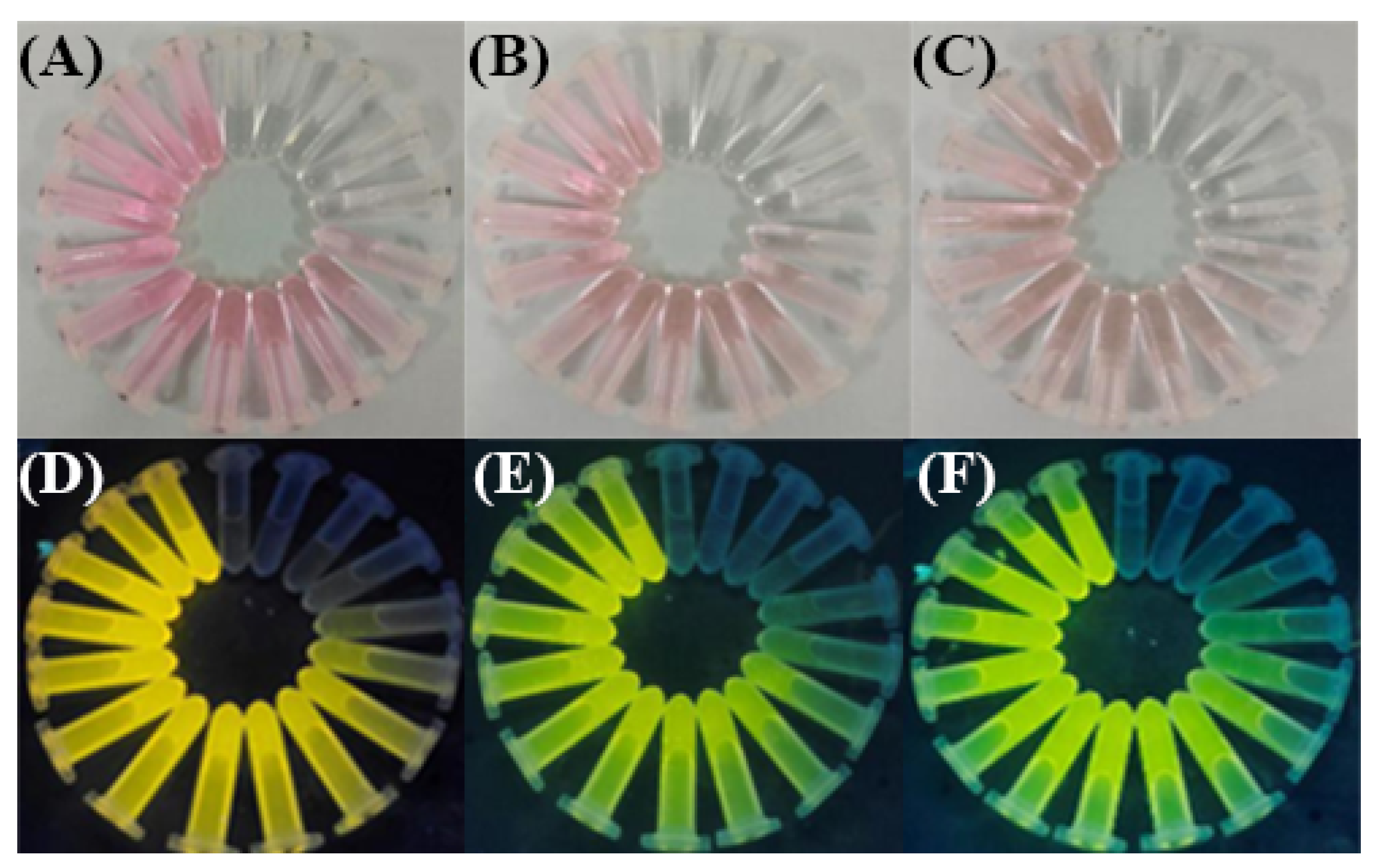
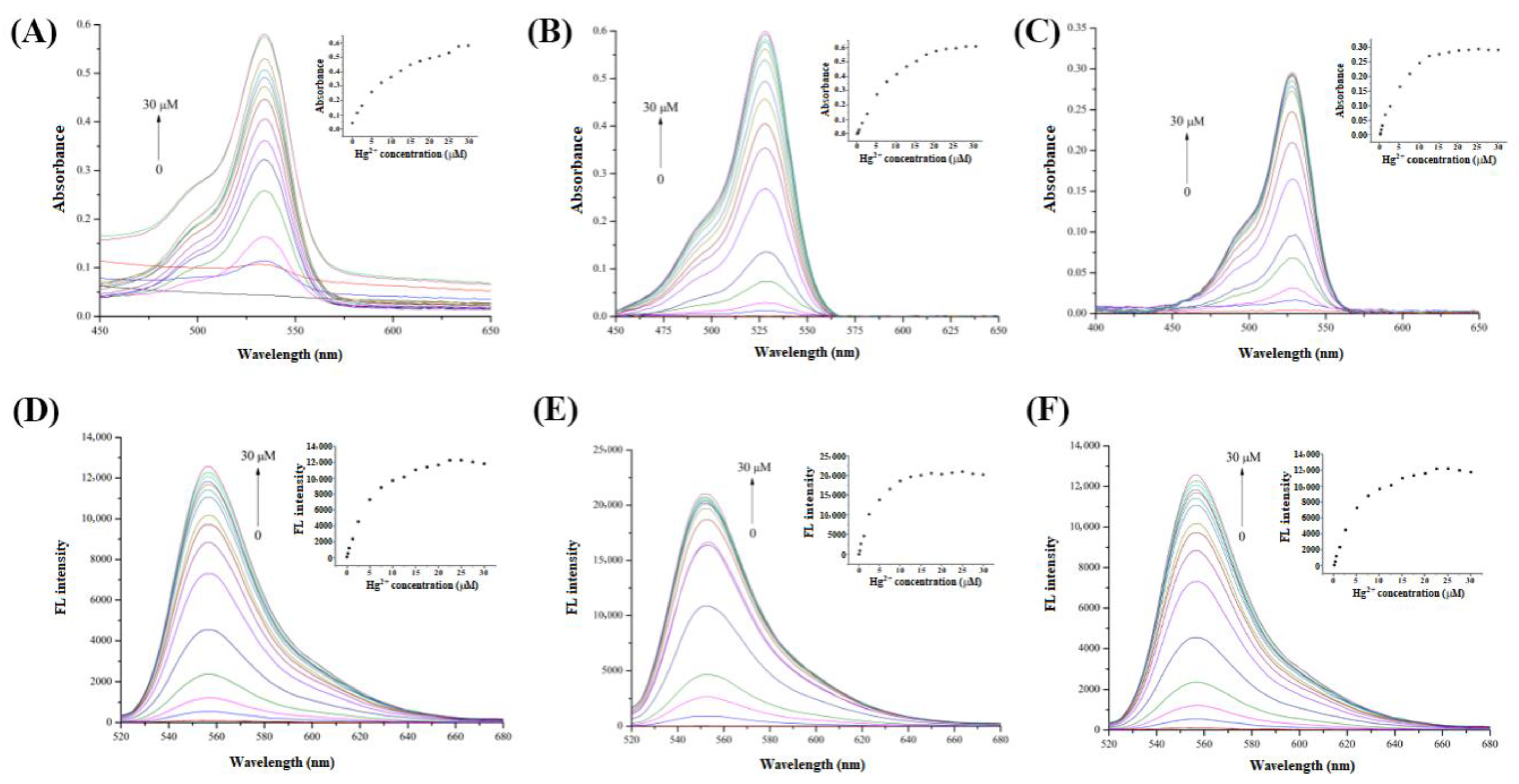
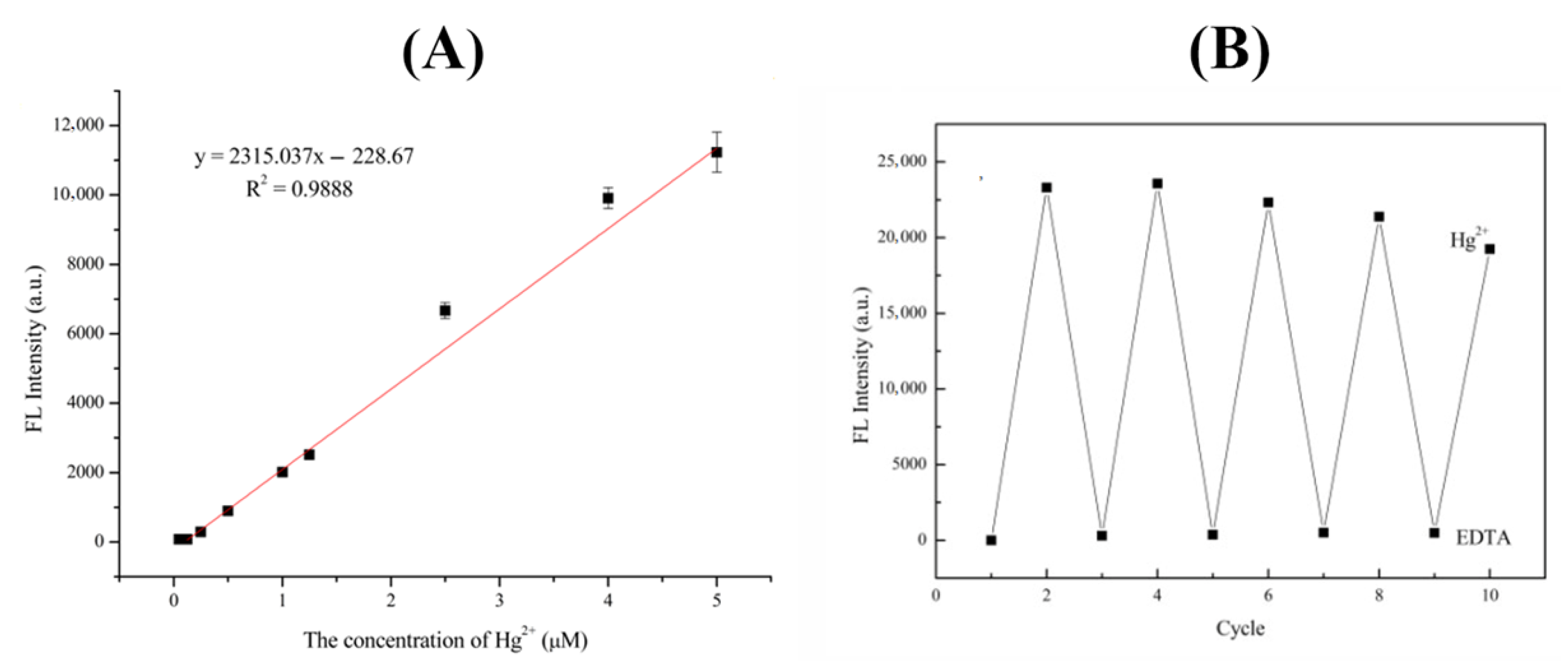
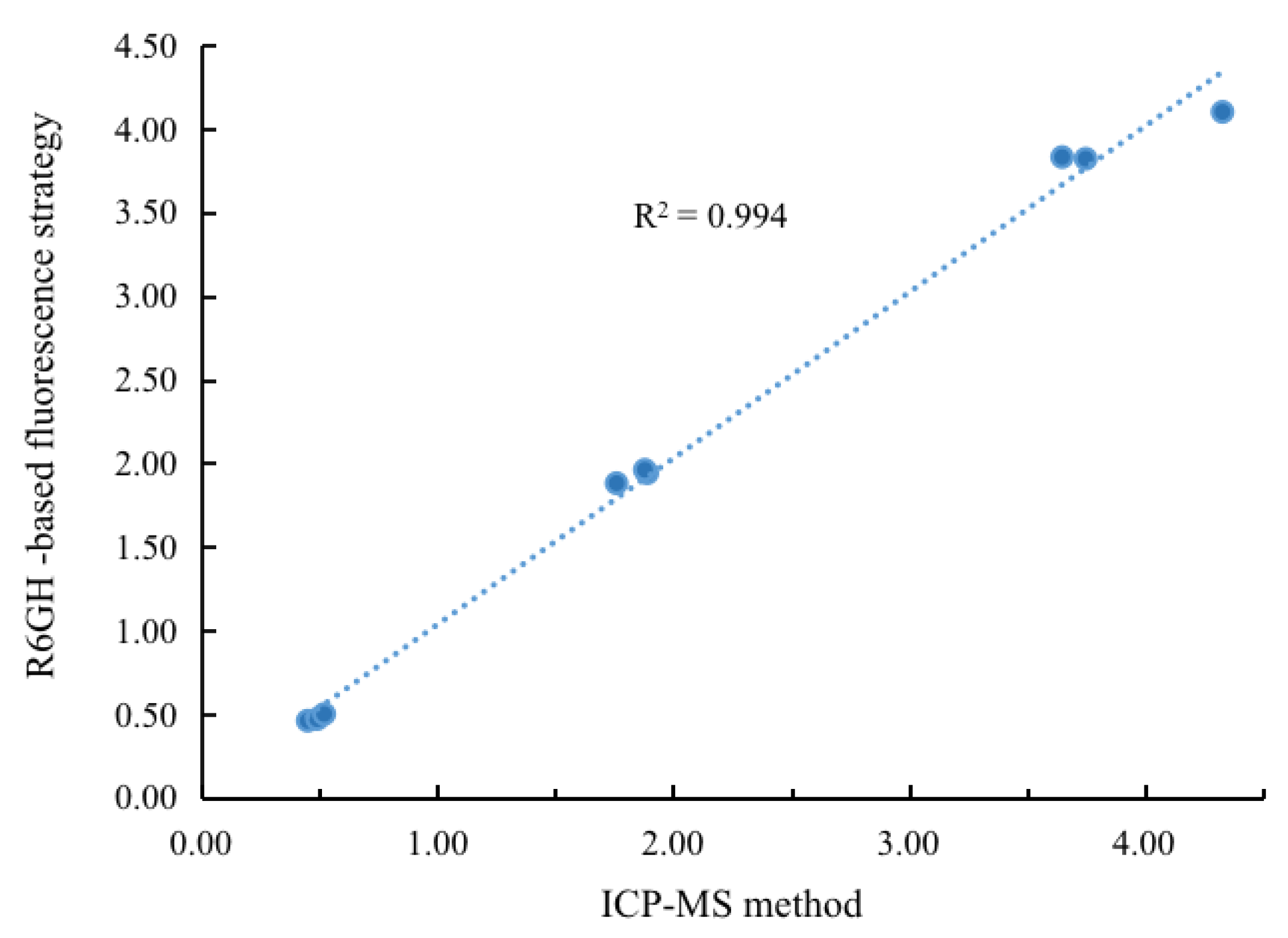
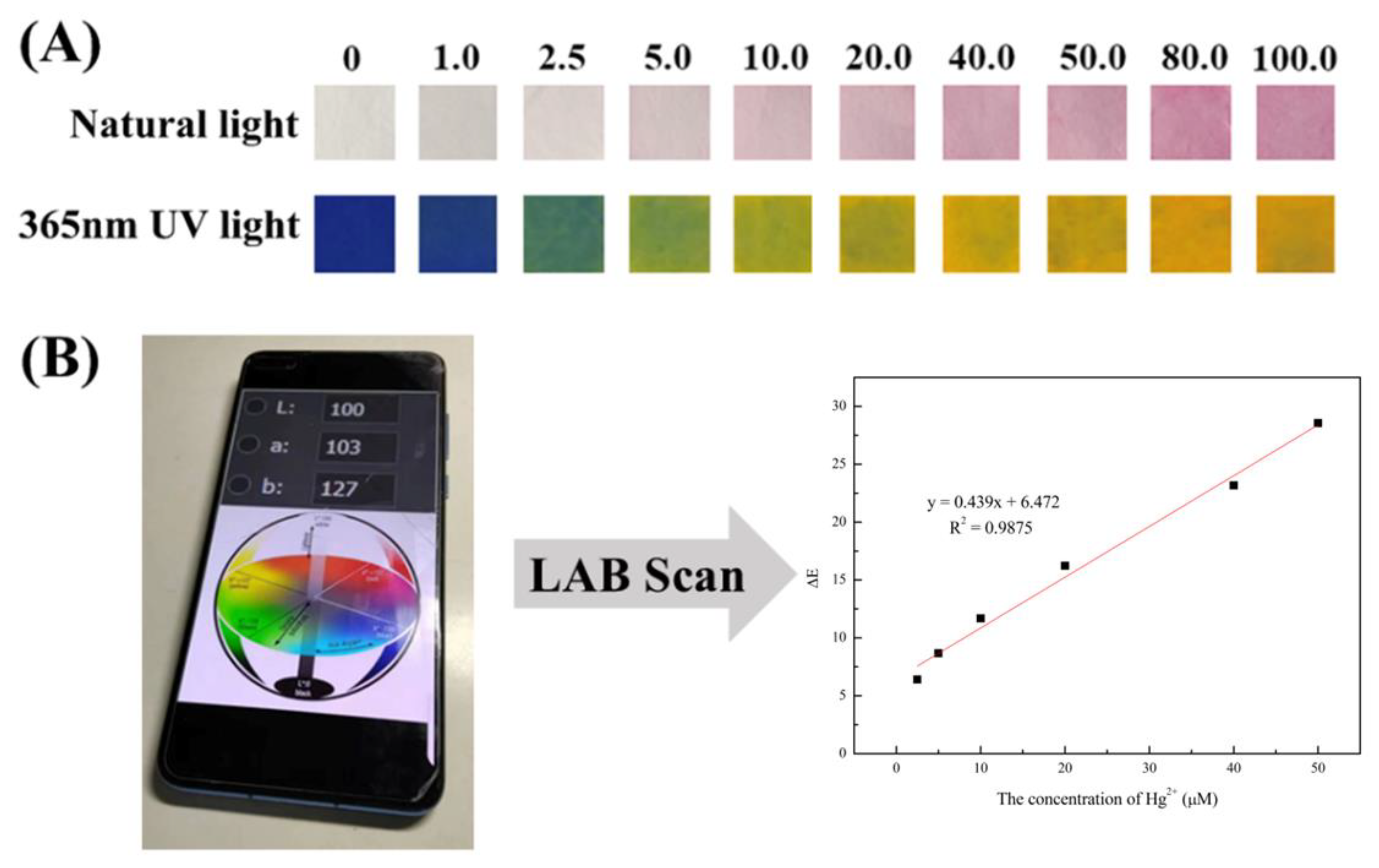
| Seafood | Spiked Level (μM) | R6GH-Based Fluorescence Strategy | ICP-MS Method | ||||
|---|---|---|---|---|---|---|---|
| Found (μM) | Recovery (%) | RSD (%, n = 3) | Found (μM) | Recovery (%) | RSD (%, n = 3) | ||
| Oysters | 0.5 | 0.45 | 89.2 | 4.7 | 0.46 | 92.0 | 3.6 |
| 2.0 | 1.76 | 88.0 | 3.5 | 1.88 | 94.0 | 3.2 | |
| 4.0 | 3.65 | 91.3 | 3.2 | 3.83 | 95.8 | 2.3 | |
| Yellow croaker | 0.5 | 0.49 | 97.2 | 4.4 | 0.47 | 94.0 | 4.1 |
| 2.0 | 1.89 | 94.7 | 2.8 | 1.94 | 97.0 | 3.1 | |
| 4.0 | 4.33 | 108.3 | 3.3 | 4.10 | 102.5 | 2.5 | |
| Prawn | 0.5 | 0.52 | 103.6 | 4.0 | 0.50 | 100.0 | 3.7 |
| 2.0 | 1.88 | 94.0 | 3.8 | 1.96 | 98.0 | 2.2 | |
| 4.0 | 3.75 | 93.8 | 2.4 | 3.82 | 95.5 | 1.9 | |
| Methods | Materials | Linear Range | LOD | Required Time | Ref. |
|---|---|---|---|---|---|
| Multicapillary GC-ICP-MS | - | 0.002–10 pg mL−1 | 0.08 pg | - | [6] |
| ICP-MS/MS | - | 1.7–325.6 ng g−1 | 0.85 ng L−1 | - | [7] |
| Fluorescent | Carbon nanodots | 0–3 μM | 4.2 nM | ~10 min | [26] |
| Ultraviolet spectrophotometry | Gold Nanorods | 285 nM–8.00 μM | 112 nM | - | [27] |
| Ratiometric fluorescent paper | Dual-colored carbon dots | 0–320 nM | 0.14 nM | ~3 min | [28] |
| Electrochemical biosensor | Poly-T oligonucleotides | 1 nM–1.0 mM | 100 pM | ~30 min | [29] |
| Fluorimetry and visualization assay | R6GH | 0–5 μM | 0.025 μM | <10 min | This work |
Disclaimer/Publisher’s Note: The statements, opinions and data contained in all publications are solely those of the individual author(s) and contributor(s) and not of MDPI and/or the editor(s). MDPI and/or the editor(s) disclaim responsibility for any injury to people or property resulting from any ideas, methods, instructions or products referred to in the content. |
© 2023 by the authors. Licensee MDPI, Basel, Switzerland. This article is an open access article distributed under the terms and conditions of the Creative Commons Attribution (CC BY) license (https://creativecommons.org/licenses/by/4.0/).
Share and Cite
Zhang, Z.; Han, R.; Chen, S.; Zheng, F.; Ma, X.; Pan, M.; Wang, S. Fluorescent and Colorimetric Dual-Mode Strategy Based on Rhodamine 6G Hydrazide for Qualitative and Quantitative Detection of Hg2+ in Seafoods. Foods 2023, 12, 1085. https://doi.org/10.3390/foods12051085
Zhang Z, Han R, Chen S, Zheng F, Ma X, Pan M, Wang S. Fluorescent and Colorimetric Dual-Mode Strategy Based on Rhodamine 6G Hydrazide for Qualitative and Quantitative Detection of Hg2+ in Seafoods. Foods. 2023; 12(5):1085. https://doi.org/10.3390/foods12051085
Chicago/Turabian StyleZhang, Ziwen, Ran Han, Sixuan Chen, Feilin Zheng, Xinmiao Ma, Mingfei Pan, and Shuo Wang. 2023. "Fluorescent and Colorimetric Dual-Mode Strategy Based on Rhodamine 6G Hydrazide for Qualitative and Quantitative Detection of Hg2+ in Seafoods" Foods 12, no. 5: 1085. https://doi.org/10.3390/foods12051085




